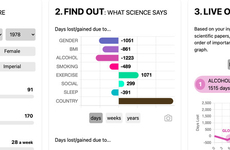
The 'Living with Multiple Sclerosis' Chart Shows Effects
Jennifer Gosnell — June 2, 2012 — Lifestyle
References: visual.ly
The 'Living with Multiple Sclerosis' infographic is a very interesting chart on who the disease affects, what it does, and where it is most prevalent. In Europe alone the inflammatory disease affects over 600,000 people, with the highest area of issue being Germany with 100,000+ people living with the disease. Luckily, Germany ranks as #1 for having the highest quality of life for people living with MS, closely followed by Iceland and Sweden.
Using the body outline, the infograph also highlights what MS actually does and how the people that live with MS are affected. Most people experience some form of balance or coordination problems, nerve issues and fatigue among other symptoms. The consequences of these affects of MS result in pain, difficulties moving and sleep problems.
The infographic is a fascinating look at a quite common disease that affects a lot of people.
Using the body outline, the infograph also highlights what MS actually does and how the people that live with MS are affected. Most people experience some form of balance or coordination problems, nerve issues and fatigue among other symptoms. The consequences of these affects of MS result in pain, difficulties moving and sleep problems.
The infographic is a fascinating look at a quite common disease that affects a lot of people.
Trend Themes
1. Increasing MS Awareness - Disruptive innovation opportunity: Develop innovative campaigns and platforms to raise awareness about multiple sclerosis and its impact on individuals and communities.
2. Improving Quality of Life - Disruptive innovation opportunity: Create advanced technologies and supportive solutions to enhance the quality of life for people living with multiple sclerosis.
3. Personalized Treatment Approaches - Disruptive innovation opportunity: Explore personalized medicine and targeted therapies to tailor treatment plans for individuals with multiple sclerosis based on their unique symptoms and needs.
Industry Implications
1. Medical Research - Disruptive innovation opportunity: Conduct further research on multiple sclerosis to develop novel treatments, therapies, and interventions.
2. Healthcare Technology - Disruptive innovation opportunity: Leverage cutting-edge technologies like artificial intelligence, wearables, and telemedicine to improve monitoring, diagnostics, and remote care for individuals with multiple sclerosis.
3. Pharmaceuticals - Disruptive innovation opportunity: Invest in the development of innovative and targeted medications to address the symptoms and disease progression of multiple sclerosis.
2.8
Score
Popularity
Activity
Freshness
























